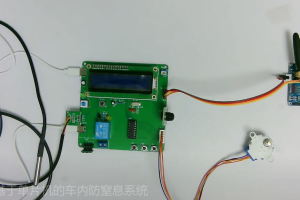设计说明书
总字数:19000+
摘要
随着汽车保有量增长与家庭用车场景普及,儿童、老人被误锁车内引发的窒息事故频发。封闭车内短时间内易出现温度骤升、CO₂浓度积聚,尤其车辆熄火后通风中断,环境恶化速度加快,若未能及时发现干预,将严重威胁被困人员生命安全。当前多数车辆缺乏主动防窒息监测与干预机制,依赖驾驶员主观检查,存在极大安全隐患。因此,研发一款能实时监测车内环境、自动识别人员、触发救援干预的车内防窒息控制系统,对防范此类安全事故具有迫切现实意义。
本设计提出一种基于 STC89C52 单片机的车内防窒息控制系统。系统核心功能包括:通过 DS18B20 传感器实时检测车内温度,SGP30 传感器监测 CO₂浓度;借助 D203S 人体热释电传感器识别车内是否有人,继电器模拟车辆熄火 / 未熄火状态;当检测到车内有人且车辆未熄火时,若温度或 CO₂浓度超出阈值,通过 ULN2003A 驱动步进电机模拟打开车窗;若车辆已熄火且环境参数异常,系统通过 SIM900A GSM 模块向监护人员手机发送救援短信,并同步驱动步进电机开窗;支持通过按键自定义温度、CO₂浓度报警阈值,LCD1602 显示屏实时显示环境参数与系统状态,确保信息直观可读。
该车内防窒息控制系统的作用在于,构建 “环境监测 – 人员识别 – 状态判定 – 分级干预” 的全流程安全防护机制:实时监测车内关键环境参数,精准捕捉风险信号;区分车辆熄火 / 未熄火状态,采取 “开窗通风”“短信救援” 的分级干预策略,提升救援针对性;阈值可设置与数据可视化功能,适配不同车型与使用场景需求。整体系统为车辆安全防护提供了低成本、高可靠性的主动解决方案,有效弥补传统车辆安全配置的不足,为车内人员生命安全增添重要保障。
关键词:STC89C52;防窒息;DS18B20;SGP30;SIM900A
Design of anti suffocation control system for car interior based on single-chip microcomputer
Abstract
With the growth of car ownership and the popularization of household use scenarios, suffocation accidents caused by children and the elderly being mistakenly locked in cars have become frequent. A sudden temperature rise and accumulation of CO ₂ concentration are prone to occur in a closed car for a short period of time, especially when the ventilation is interrupted after the vehicle is turned off, which accelerates the deterioration of the environment. If not detected and intervened in a timely manner, it will seriously threaten the safety of trapped personnel. Currently, most vehicles lack active anti suffocation monitoring and intervention mechanisms, relying on subjective inspections by drivers, which poses significant safety hazards. Therefore, developing an in car anti suffocation control system that can monitor the in car environment in real time, automatically identify personnel, and trigger rescue interventions is of urgent practical significance for preventing such safety accidents.
This design proposes an in car anti suffocation control system based on STC89C52 microcontroller. The core functions of the system include: real-time detection of the temperature inside the vehicle through DS18B20 sensor, and monitoring of CO ₂ concentration through SGP30 sensor; Using the D203S human body pyroelectric sensor to identify whether there is a person inside the vehicle, and simulating the vehicle’s shutdown/non shutdown state with a relay; When someone is detected in the car and the vehicle is not turned off, if the temperature or CO ₂ concentration exceeds the threshold, the ULN2003A drives the stepper motor to simulate opening the car window; If the vehicle has been turned off and the environmental parameters are abnormal, the system sends a rescue message to the monitoring personnel’s mobile phone through the SIM900A GSM module and synchronously drives the stepper motor to open the window; Support customizing temperature and CO ₂ concentration alarm thresholds through buttons, with real-time display of environmental parameters and system status on the LCD1602 screen, ensuring intuitive and readable information.
The function of the anti suffocation control system in the car is to establish a full process safety protection mechanism of “environmental monitoring personnel identification status determination graded intervention”: real-time monitoring of key environmental parameters in the car, accurate capture of risk signals; Distinguish between vehicle shutdown/non shutdown states, adopt a graded intervention strategy of “window ventilation” and “SMS rescue” to enhance the targeted rescue; Threshold can be set and data visualization function can be used to adapt to different vehicle models and usage scenarios. The overall system provides a low-cost and highly reliable proactive solution for vehicle safety protection, effectively compensating for the shortcomings of traditional vehicle safety configurations and adding important guarantees for the safety of passengers in the vehicle.
Keywords:STC89C52; Prevent suffocation; DS18B20; SGP30; SIM900A
目 录
1 绪论
1.1 研究背景及意义
1.2 国内外研究现状
1.3 主要内容
2 系统总体方案设计
2.1系统总体设计
2.2 主要模块方案选择
3 系统硬件设计
3.1 总体硬件框架
3.2 主控模块电路设计
3.3 温度检测模块电路设计
3.4 CO₂检测模块电路设计
3.5 人员检测模块电路设计
3.6 车辆状态模拟模块电路设计
3.7 开窗执行模块电路设计
3.8 短信报警模块电路设计
3.9 显示模块电路设计
3.10 按键模块电路设计
4 系统程序设计
4.1 编程软件介绍
4.2 系统主流程设计
4.3 温度检测模块子流程设计
4.4 SGP30模块子流程设计
4.5 人体热释电感应模块子流程设计
4.6 步进电机子流程设计
4.7 发送短信子流程设计
4.8 独立按键子流程设计
4.9 OLED显示屏子流程设计
5 实物制作与功能测试
5.1 实物制作
5.2 多参数环境监测与显示功能测试
5.3 车辆状态模拟与分级开窗功能测试
5.4 短信报警功能专项测试
5.5 阈值设置功能测试
6 总结
参考文献
致谢
附录A 原理图
附录B PCB
附录C 主程序
购买后可查看具体内容!

